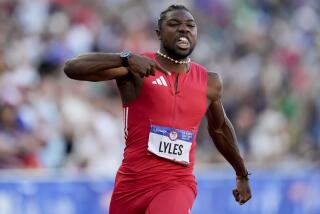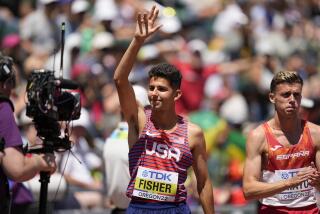Ryun Never Heard the Footsteps--or Much Else
- Share via
He was the best miler in the world for nine years. He was the world record-holder, also, in the 1,500 meters and in the 800 meters.
He was an elegant runner who had the deceptive kick of Man o’ War at the tape. He accelerated without seeming to.
He was a cinch to become the first American to win the Olympic gold medal in the metric mile since 1908.
What nobody knew was, Jim Ryun couldn’t hear the cheers. Even more important, he was no more than even money to hear the gun. Some guys with keen hearing get off the blocks when the hammer clicks. Jim Ryun needed the explosion.
Ryun was born with a hearing impairment. He wasn’t deaf. But he could hear only half as well as he should have.
The mile is a race in which hearing can be important, if not critical. The sound of footsteps, the officials barking off the splits, the sound of the crowd, all contribute to your pace. Ryun ran it in semi-silence.
For years, track and field experts were mystified by Ryun’s penchant for looking over his shoulder, even in some of his record races. A famous picture of the 1968 Olympics shows him in second place, behind Kip Keino in the 1,500, casting a desperate look so far over his shoulder he is almost turned around and running backward as he tries to see what’s coming up behind him.
He wore a wristwatch in all his races, checking it surreptitiously lap by lap. He also would watch the scoreboard clock. He needed visual aids. He raced in a near vacuum.
Oddly enough, it was not fear of not hearing the gun, nor the approach of rivals, that tortured Jim Ryun the most. It was post-race interviews.
“I was fine on one-on-one, close-at-hand interviews,” he says. “But I hated to go in a room for mass interviews. I was terrified of misunderstanding the questions and giving a completely irrelevant answer and having everybody laugh at me or ridicule me.”
An ear doctor once told him: “You’re a pretty bright guy because you’ve done a remarkable job of covering up your hearing loss.”
But Jim Ryun was born to run, and the sound of silence wasn’t to keep him from it. At 6 feet 3 and 140 pounds, he was the most graceful at his distances since the legendary Mal Whitfield. Other runners ran with face-contorted effort. Ryun ran with the effortless grace of a thoroughbred.
America has had terrible luck in the metric mile. Not since the London Olympics of 1908 have we come up with the gold in the 1,500. Even though the United States produced such world-renowned milers as Glenn Cunningham, Gene Venzke and Archie San Romani, it was always Yankee go home without the gold when Olympic time came around. The best we could do with that imposing cast of competitors--Cunningham held the world record for the mile at 4:06.8 before his second Olympics in 1936, and Bill Bonthron the world record for the 1,500 at 3:48.8--was a silver medal for Cunningham in Berlin in ’36.
Ryun was going to change all that. In 1968, he was widely believed to have been the best miler ever. He had qualified for the 1964 Olympics as a schoolboy--only 17 at the time--and he was to improve annually till he set his first world record in the mile, 3:51.3 in 1966. It was a mark he broke a year later with a 3:51.1. In 1967, he broke the 1,500-meter world record with 3:33.1, a mark that held for five years.
Victory in the 1968 Olympics was a foregone conclusion--except for one thing: The Games that year were to be held in Mexico City. That’s 7,395 feet above sea level. That’s where the oxygen deficit increases exponentially and where Dr. Roger Bannister, the Brit who ran the first sub-four-minute mile, predicted medical catastrophes for sea-level runners going a distance.
Ryun was one of them. Running against Keino, a Kenyan who had never beaten him, Ryun lost his edge. Keino, raised almost on the slopes of Mt. Kilimanjaro, was as at home in the rarefied altitudes as a snow leopard.
Keino could handle the blistering early pace of countryman Ben Jipcho. Ryun could not. A few weeks of altitude training in Colorado could not compete with lungs born and raised at altitude in Africa. Keino also ran in the 10,000 at Mexico City, he took the silver medal in the 5,000 and won the 1,500, beating Ryun by 20 meters.
As disappointing as that was for Ryun, it was only prologue. In 1972, at Munich, Ryun, still the world record-holder, ran in the first 1,500 heat, having only to finish fourth in a field of 10 runners to move on to the semifinals. Inexplicably, he ran into a tangle 550 meters from the finish and tumbled heavily to the ground. He had been rear-ended by a journeyman runner from Ghana, Billy Fordjour.
Did Ryun not hear Fordjour drawing up? Was he compromised by his infirmity?
Ryun shakes his head. “With a lap and a quarter to go, I just went to make my move. I was brushed by another runner (Mohamed Younis of Pakistan) and fell backward into Fordjour.”
The stunning development rocked the track world into initially thinking Ryun might have a legitimate appeal. It was not to be.
Did he go into hiding, shun the public? Ryun shakes his head again.
“I became a Christian. I struggled with hurt and bitterness over the incident. Went through the ‘Why me, Lord?’ I said, ‘Lord, you know those Olympic officials know I was fouled!’ Then, one day, I learned forgiveness. God showed me how to become a real winner. I realized I was being tested.”
Shortly after that, there was a hearing breakthrough.
“For years, all I heard was, ‘There is nothing we can do.’ The hearing aids were only somewhat effective. They were merely amplification devices. Then, one day, they brought out a new invention, a programmable hearing device that really lets you hear.”
Today, Jim Ryun runs for ear research. More than 41 million people in the U.S. experience some kind of hearing difficulty, he points out. That’s almost one-sixth of the nation. More than 16 million are hearing impaired. Jim Ryun was one of them.
He is at the forefront of a drive for better hearing as chairman of the Council For Better Hearing & Speech Month.
“With these new programmable hearing devices, we can now hear sounds the way everyone hears them,” he says. “I’ll never forget the day I was standing in a field in Kansas and I heard this sound and I said, ‘What’s that?’ And they said, ‘It’s the sound of geese flying over.’ I was thrilled. I must have been around that sound all my life and never heard it before.”
He got his gold medal after all.
More to Read
Go beyond the scoreboard
Get the latest on L.A.'s teams in the daily Sports Report newsletter.
You may occasionally receive promotional content from the Los Angeles Times.






